Earlier this year, we published the Law Firm & Legal Services edition of our 2024 High Growth Study. This study examines law firms and legal services (for brevity, we’ll refer to these as “law firms” from now on) from a variety of marketing and operational perspectives: marketing and business development, strategy, talent and technology. But the main thrust of the study is on the High Growth segment—those firms that achieve extraordinary growth year after year.
After two consecutive years of decline, law firm growth rates have begun to rise again. We can look to the top-performing practices to understand what they do differently and how ordinary firms can emulate their success.
Today, we consider five takeaways from the research. You can find many more insights in the breakout legal industry report. First, let’s learn a bit about the study and these High Growth firms.
About the Study
76 law firms and legal services practices participated in this year’s High Growth Study, representing $7.5 billion in combined revenue and more than 55,000 full-time equivalent employees.
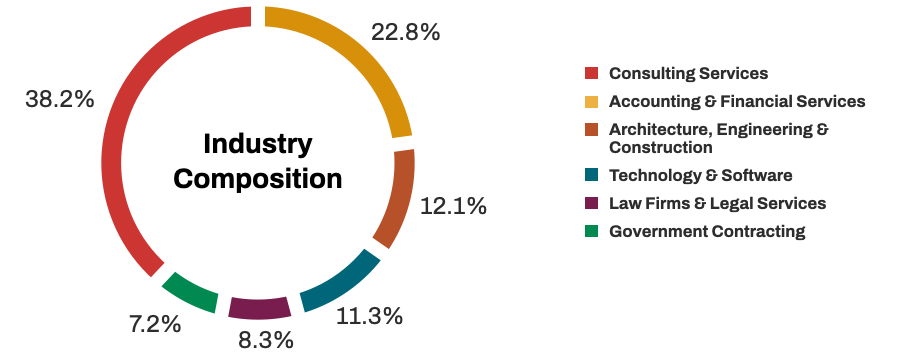
Participants represented firms of all sizes, and they conducted business in every region of the globe. We grouped the participating firms into three categories: High Growth (see definition in the section below), No Growth (those that experienced zero or negative growth), and Average Growth (the balance of the sample).
Get to Know the High Growth Firms
We define High Growth firms as those firms that achieve at least 20% compound annual growth over a three-year evaluation period. We contrast these firms against those that experienced little or no growth over the same time frame. This allows us to identify strategies and practices that are associated with faster growth and higher profits.
This year’s High Growth law firms grew at a median rate of 29.6%—more than three-and-a-half times faster than their Average Growth peers.
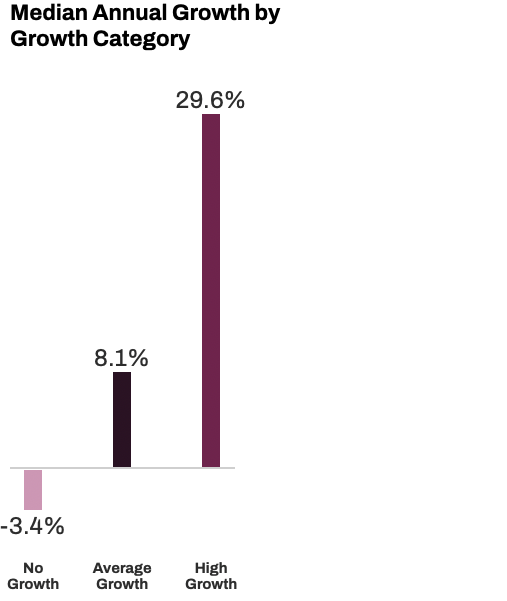
Now, let’s look at the study findings themselves. Below are five key insights into the High Growth cohort—and what they may mean for your own practice.
1: High Growth Firms Spend More on Marketing
What should your firm’s marketing budget be? It’s a question we hear often. The median marketing budget of firms that don’t grow at all is 5% of overall revenue. The best performing firms, by contrast, spend 16.5% on marketing. That’s more than three times as much.

Does this mean you should be spending over 16% of revenue on marketing? Maybe, but not necessarily. Keep in mind that these numbers are medians, so half of the sample falls below that threshold and half above. Start by looking at your own marketing budget (don’t include salaries). Where does it fall in this range? If it is closer to 5%, you may want to consider bumping it up. You can do this a little at a time or, if your budget allows, make a larger jump. Either way, keep an eye on your business development performance. Is the increased spend working? If not, why?
Of course, spending alone isn’t a panacea. You have to spend it on activities that deliver results. So where should you invest your increased budget? We’ll start answering that next.
2: High Growth Firms Invest in Marketing Techniques that Work
Where are High Growth law firms spending their marketing dollars? In the chart below, we see the seven marketing techniques they use most often.
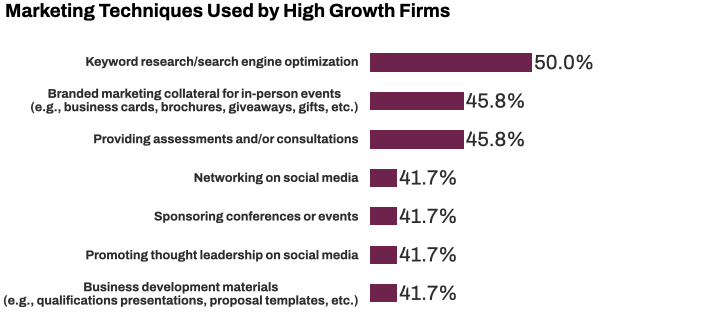
The most popular activity is SEO (including keyword research). Search engine optimization is a tried-and-true digital marketing technique. While Google’s algorithm updates over the past few years have incrementally reduced the rate at which searchers click through to web pages, there is still no single better tool to build visibility. Combined with a robust blogging program, SEO can deliver highly interested and motivated prospects to your website (creating content is a top priority of High Growth law firms).
The best performing firms also invest in high-quality marketing collateral and business development materials—everything from stationery and brochures to pitch decks and proposal templates. If you want to win a high percentage of your opportunities, you have to put your best foot forward.
To start building a relationship with prospects up front, these firms offer (typically free) consultations or assessments. In this way, people can meet the attorneys they will be working with and begin imagining what a long-term relationship might be like.
If you are interested in seeing the complete list of techiques, you can purchase the breakout legal industry study. Among many other insights, it also details which techniques deliver the most impact and which provide the greatest ROI for the least time and money.
3: They Get More Online Leads
High Growth firms get almost 25% more leads from online sources than their No Growth competitors. And they represent almost a third of their total leads.
If you are getting less than 30% of your leads from online sources, you may want to look to the High Growth firms to learn how they do it. One place to start is with the list in #2 above.
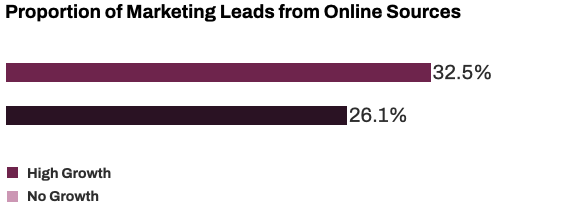
4: High Growth Firms Are Better at Monitoring Results
High Growth firms are more likely to track marketing performance metrics—and have higher confidence in them—than their slower-growing peers. Only 15% of No Growth firms expressed high confidence, compared to almost 35% of High Growth firms. Half of the No Growth group had low confidence in their ability to track these metrics.

One of the biggest advantages of modern digital marketing is its objectivity. We can fire up the analytics in whatever platform we are using and see how well it is working—often in real time. That unleashes a whole world of testing. Whether you are posting on social media, sending out emails, running a digital ad campaign or using a popup on your website to convert visitors, you can test different text, offers, colors and images to find out what your audience responds to. It is this experimental mindset that separates elite performers from the rest.
Even offline marketing and business development techniques can be tracked, though often with less precision. How many leads did you receive after delivering a speech? How many referrals did you receive over the past month? Is face-to-face networking producing the level of new business you expected? How many times has your firm been mentioned in the media?
Some traditional forms of marketing, such as print advertising and sponsorships, are more difficult to assess. That’s why many firms are de-emphasizing expensive “brand awareness” campaigns like these, though in certain situations they can create familiarity with your firm’s name. But don’t count on them moving the needle unless you can throw an inordinate amount of money at them.
5: They Are More Active in M&A
Mergers and acquisitions were a common practice in 2023, the year we collected our data. A third of No Growth firms were either acquired or merged with another firm. But in the High Growth group, a whopping 55.6% engaged in M&A activity.
Consolidation has always been a part of the legal landscape, and last year it was heating up again. Some firms use acquisitions as a major part of their growth strategy, as well as a way to obtain specialized expertise in a challenging job market. Of course, High Growth firms tend to be in a better position to afford to buy growth. And a brightening economic landscape may have contributed to their confidence.
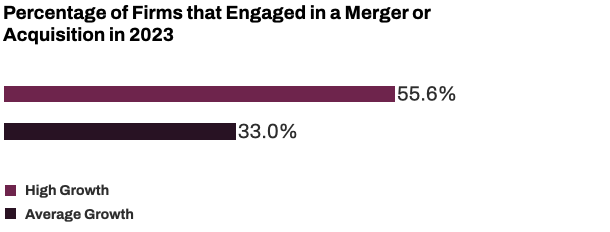
What Next?
This year’s study has brought a number of interesting—and useful—insights to the surface. But what do you do with them?
The first step is to take this data back to your partners. Then ask yourselves a series of questions:
- Are you in the High Growth bracket? If not, you’ve now got a set of benchmarks to target.
- What marketing techniques do you favor, and how do they stack up against the High Growth cohort? You may discover that you are prioritizing the wrong techniques or investing too little in them.
- How much do you budget for marketing? (Remember, this should not include labor costs.) Do you need to raise your marketing budget in order to generate more opportunities?
- Are you using content marketing and SEO to generate visibility and bring qualified prospects to your website? (And is your website a place that positions you as a highly credible resource?)
- Are you actively using metrics in your marketing? If so, are doing anything with them to improve your marketing and business development performance?
If you find your firm is lacking in some or all of these areas, take comfort in the fact you’re not alone. Then take action. The good news is that it doesn’t necessarily take a lot of effort to make a measurable improvement in your performance. And don’t think you have to take it all on alone. High Growth firms are big believers in outsourcing marketing skills that they lack in-house.
Equipped with the right information—and a dose of self-discipline—you’ll be surprised at the progress you can make in a short amount of time.

